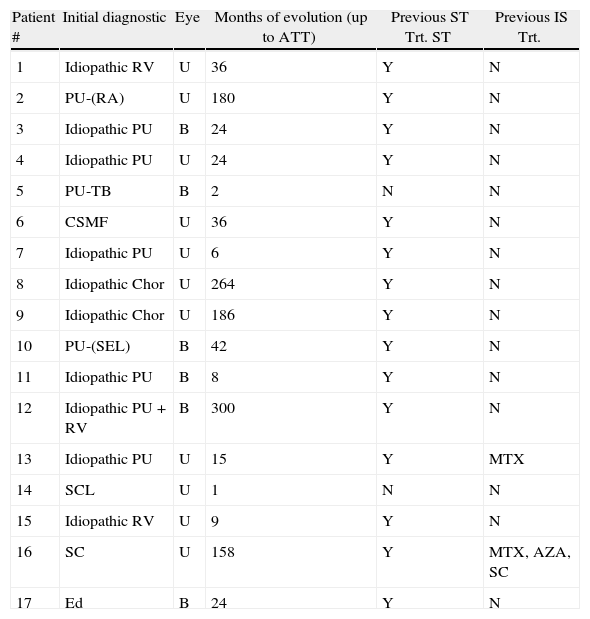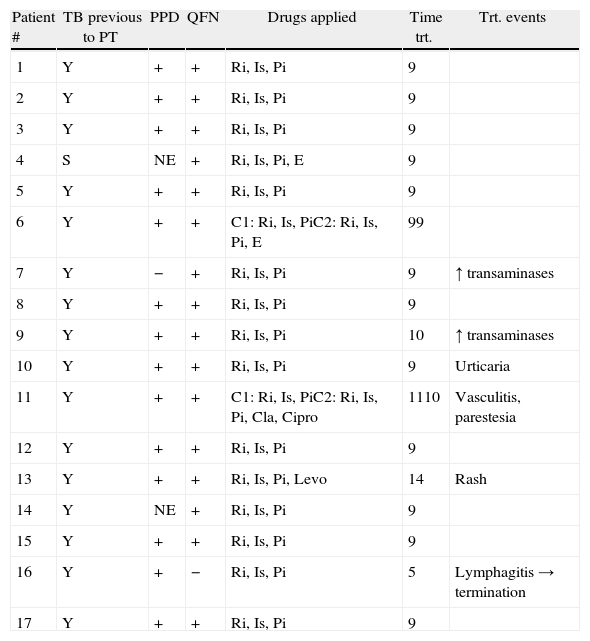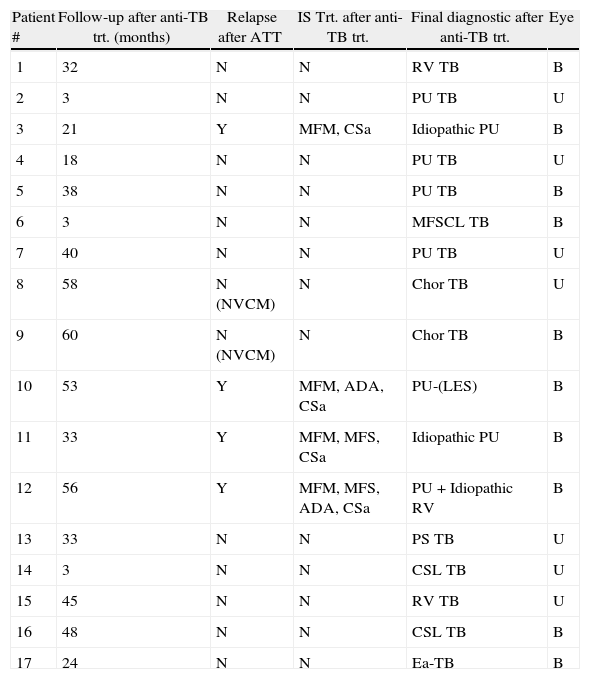To determine the level of agreement with the presumed diagnosis and long term clinical outcomes after antituberculous therapy (ATT) in a group of patients with presumed tuberculous uveitis (PTU) affecting the posterior segment.
MethodsRetrospective case series.
ResultsA total of 17 patients with chronic refractory or newly diagnosed uveitis affecting the posterior segment were included. All included patients were diagnosed with PTU and received ATT. Median follow-up after ATT was 34 months (range 2–60). Complete control of inflammation was observed in 14/17 patients (82.3%) during the treatment period, and only 4/17 patients (23.5%) had a uveitis relapse over the entire follow-up period after ATT. All patients who had uveitis relapses (4/4), but none from the remaining group (0/13), required immunosuppressive therapy of some kind after ATT. The response to ATT was able to confirm diagnosis of PTU in 14/17 (82.3%) included patients.
ConclusionWhen a clinical suspicion of PTU affecting the posterior segment exists, ATT may be highly effective for both confirming the diagnosis and resolving the inflammatory process. Thus, ATT may offer additional advantages, such as preventing latent-tuberculosis reactivations due to immunosuppressive therapy, and decreasing the number and/or severity of uveitis relapses in some patients. Prospective, randomized studies including a larger number of patients are required to support these and other potential advantages of ATT in such patients.
Describir el grado de coincidencia con el diagnóstico de presunción así como los resultados clínicos obtenidos a largo plazo tras el tratamiento antituberculoso (ATT) en un grupo de pacientes con uveítis tuberculosas presuntas (UTBP) que afectaban al segmento posterior.
MétodosEstudio retrospectivo. Serie de pacientes.
ResultadosSe incluyeron a 17 pacientes con distintos tipos de uveítis del segmento posterior, crónicas, refractarias o de reciente diagnóstico y diversas manifestaciones clínicas, en los que, tras establecerse el diagnóstico de UTBP, se completó ATT. La media de seguimiento fue de 34 meses (rango 2-60). Hubo control de la inflamación en 14/17 pacientes (82,3%) durante el periodo de tratamiento y solo 4/17 pacientes (23,5%) experimentaron una recidiva de su enfermedad a lo largo del periodo de seguimiento tras ATT. Todos los pacientes que sufrieron recidivas (4/4), pero ninguno de los que no las sufrieron (0/13) requirieron terapia inmunosupresora de algún tipo tras ATT. La respuesta al ATT sirvió para confirmar el diagnóstico de UTBP en 14/17 pacientes (82,3%).
ConclusionesEn pacientes con sospecha de UTBP que afecta al segmento posterior, el ATT puede ser una eficaz medida para confirmar el diagnóstico y resolver el cuadro inflamatorio. En este contexto, el ATT puede ofrecer otras potenciales ventajas como prevenir futuras reactivaciones de tuberculosis secundarias a tratamiento inmunosupresor o disminuir la frecuencia o la severidad de recaídas en algunos pacientes. La confirmación de estas y otras ventajas requiere trabajos prospectivos, aleatorizados con mayor número de pacientes.











